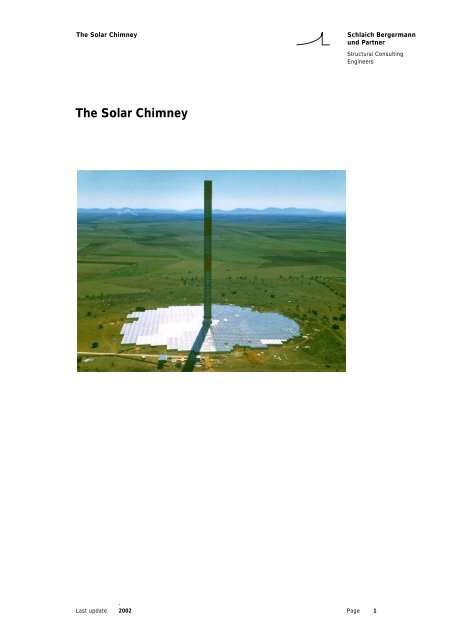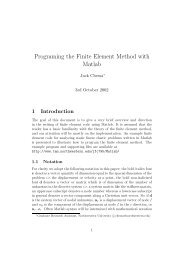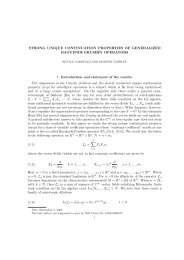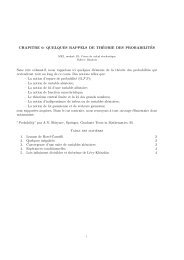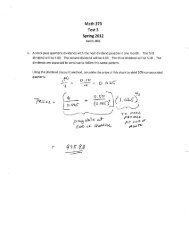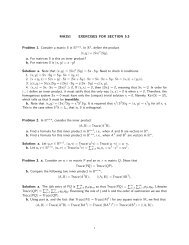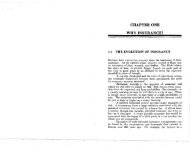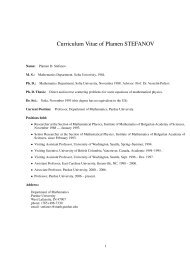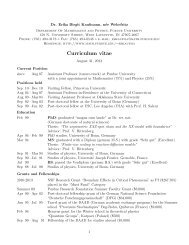The Solar Chimney
The Solar Chimney
The Solar Chimney
Create successful ePaper yourself
Turn your PDF publications into a flip-book with our unique Google optimized e-Paper software.
<strong>The</strong> <strong>Solar</strong> <strong>Chimney</strong> Schlaich Bergermann<br />
und Partner<br />
<strong>The</strong> <strong>Solar</strong> <strong>Chimney</strong><br />
Structural Consulting<br />
Engineers<br />
.<br />
Last update 2002 Page 1
<strong>The</strong> <strong>Solar</strong> <strong>Chimney</strong> Schlaich Bergermann<br />
und Partner<br />
Contents<br />
1. Introduction 3<br />
2. <strong>The</strong> use of three “old“ technologies 4<br />
3. <strong>The</strong> technology 6<br />
3.1. <strong>The</strong> collector 6<br />
3.2. <strong>The</strong> energy storage 6<br />
3.3. <strong>The</strong> chimney 7<br />
3.4. <strong>The</strong> turbines 7<br />
3.5. A 'hydroelectric power station for the desert 8<br />
4. <strong>The</strong> prototype in Manzanares 8<br />
5. Designing large solar chimneys 10<br />
6. Energy Production Costs 12<br />
7. References 14<br />
Author:<br />
Schlaich Bergermann<br />
und Partner<br />
Structural Consulting<br />
Engineers<br />
Hohenzollernstraße 1<br />
D-70178 Stuttgart<br />
Telefon + 49(711)64871- 0<br />
Telefax + 49(711)64871- 66<br />
info@sbp.de<br />
http://www.sbp.de<br />
sbp gmbh<br />
Structural Consulting<br />
Engineers<br />
.<br />
Last update 2002 Page 2
<strong>The</strong> <strong>Solar</strong> <strong>Chimney</strong> Schlaich Bergermann<br />
und Partner<br />
1. Introduction<br />
<strong>The</strong> future of this earth and mankind substantially depends on our ability to slow down<br />
the population increase in the „Third World“ by civilized means. <strong>The</strong> key is to increase<br />
the standard of living, to overcome the inhumane poverty and deprivation.<br />
14<br />
18<br />
23<br />
35<br />
70<br />
5<br />
4,5<br />
4<br />
3,5<br />
3<br />
2,5<br />
2<br />
1,5<br />
1<br />
0,5<br />
0<br />
Yearly average growth of population [%]<br />
Corresp. to a doubling in years [a]<br />
Keni<br />
Äthi<br />
Nige<br />
Jord<br />
Syri<br />
Vene<br />
Ugan Ägyp<br />
Usbe<br />
Rußl Trin<br />
Peru<br />
IND Mexi<br />
C<br />
Ukra<br />
Arge<br />
Iran<br />
Alge<br />
Weiß<br />
Trin<br />
Vene<br />
Usbe<br />
Alge<br />
GR<br />
Arge Pole<br />
Mexi Weiß<br />
Rußl GR<br />
Ukra<br />
C Ägyp Jord<br />
E<br />
SWE<br />
Iran<br />
AUS<br />
E<br />
Saud<br />
Tsch<br />
Isra<br />
Bulg<br />
E<br />
I<br />
Saud<br />
Isra<br />
Tsch<br />
Nied<br />
F<br />
Fig. 1: Standard of living - energy consumption - population growth<br />
I<br />
GB<br />
GB<br />
AUS<br />
AUS<br />
To achieve this traditional means will not suffice any longer as exemplified by a "paradoxon":<br />
Those countries where agriculture provides more than 20 % of the gross national<br />
product are those also stricken by starvation!<br />
Development requires mechanization and energy. Energy consumption increases proportionally<br />
to the gross national product or prosperity while simultaneously the population<br />
growth will decrease exponentially (Fig. 1).<br />
Many developing countries possess hardly any energy sources and their population doubles<br />
every 15 to 30 years! <strong>The</strong> results are commonly known: Civil wars and fundamentalism.<br />
If these developing countries are provided with only a humane and viable minimum<br />
of energy the global energy consumption will drastically increase!<br />
Nied<br />
Who could supply such an enormous amount of energy without an ecological breakdown<br />
(because poor countries cannot afford environmental protection) and without<br />
safety hazards (because they are not acquainted with the safety requirements for nuclear<br />
power plants) and without a rapid depletion of natural resources at the expense of future<br />
generations?<br />
<strong>The</strong> sun! Many of these countries are lavishly provided with solar radiation in their desert<br />
areas.<br />
F<br />
Structural Consulting<br />
Engineers<br />
.<br />
Last update 2002 Page 3<br />
D<br />
D<br />
CAN Norw<br />
0 5.000 10.000 15.000 20.000 25.000<br />
low<br />
(65%)<br />
Developing Countries<br />
medium<br />
(25 %)<br />
Eastern Europe<br />
North America<br />
CAN<br />
SWE<br />
J<br />
J<br />
SWE<br />
high income ecconomies<br />
(10% of the world’s population of 5,5 Billion peoples)<br />
Energy consumption per capita [kWh/a]<br />
Norw<br />
USA<br />
Western Europe<br />
Industrialized Countries<br />
USA<br />
CH<br />
CH<br />
120.000<br />
100.000<br />
80.000<br />
60.000<br />
40.000<br />
20.000<br />
Gross Domestic Product per Capita (US-$)<br />
0
<strong>The</strong> <strong>Solar</strong> <strong>Chimney</strong> Schlaich Bergermann<br />
und Partner<br />
This is common knowledge, stated already in Agenda 21 of the Rio-UN-conference, everybody<br />
is talking about it, nobody does anything.<br />
Why? Because apparently it must be a well-kept secret that large-scale solar energy<br />
utilization is possible today and that it is affordable and competitive!<br />
2. <strong>The</strong> use of three “old“ technologies<br />
Man learned to make active use of solar energy at a very early stage: greenhouses<br />
helped to grow food, chimney suction ventilated and cooled buildings and windmills<br />
ground corn and pumped water.<br />
<strong>The</strong> solar chimney's three essential elements - glass roof collector, chimney, and wind<br />
turbines - have thus been familiar from time immemorial.<br />
A solar-thermal chimney simply combines them in a new way (Fig. 2).<br />
Fig. 2: Principle of the solar chimney: glass roof collector, chimney tube, wind turbines.<br />
Air is heated by solar radiation under a low circular glass roof open at the periphery; this<br />
and the natural ground below it form a hot air collector. Continuous 24 hours-operation is<br />
guaranteed by placing tight water-filled tubes under the roof. <strong>The</strong> water heats up during<br />
the daytime and emits its heat at night. <strong>The</strong>se tubes are filled only once, no further water<br />
is needed. In the middle of the roof is a vertical chimney with large air inlets at its<br />
base. <strong>The</strong> joint between the roof and the chimney base is airtight. As hot air is lighter<br />
then cold air it rises up the chimney. Suction from the chimney then draws in more hot<br />
air from the collector, and cold air comes in from the outer perimeter. Thus solar radiation<br />
causes a constant updraught in the chimney. <strong>The</strong> energy this contains is converted<br />
into mechanical energy by pressure-staged wind turbines at the base of the chimney,<br />
and into electrical energy by conventional generators.<br />
Structural Consulting<br />
Engineers<br />
.<br />
Last update 2002 Page 4
<strong>The</strong> <strong>Solar</strong> <strong>Chimney</strong> Schlaich Bergermann<br />
und Partner<br />
A single solar chimney with a suitably large glazed roof area and a high chimney can be<br />
designed to generate 100 to 200 MW continuously 24 h a day. Thus even a small number<br />
of solar chimneys can replace a large nuclear power station.<br />
<strong>Solar</strong> chimneys operate simply and have a number of other advantages:<br />
- <strong>The</strong> collector can use all solar radiation, both direct and diffused. This is crucial for<br />
tropical countries where the sky is frequently overcast. <strong>The</strong> other major large scale<br />
solar-thermal power plants, parabolic through and central receiver systems, which<br />
apply concentrators and therefore can use only direct radiation, are at a disadvantage<br />
there.<br />
- Due to the heat storage system the solar chimney will operate 24h on pure solar<br />
energy. <strong>The</strong> water tubes laying under the glass roof absorb part of the radiated energy<br />
during the day and release it into the collector at night. Thus solar chimneys<br />
produce electricity at night as well.<br />
- <strong>Solar</strong> chimneys are particularly reliable and not liable to break down, in comparison<br />
with other solar generating plants. Turbines, transmission and generator - subject to<br />
a steady flow of air - are the plant's only moving parts. This simple and robust structure<br />
guarantees operation that needs little maintenance and of course no combustible<br />
fuel.<br />
- Unlike conventional power stations (and also other solar-thermal power station<br />
types), solar chimneys do not need cooling water. This is a key advantage in the<br />
many sunny countries that already have major problems with drinking water.<br />
- <strong>The</strong> building materials needed for solar chimneys, mainly concrete and glass, are<br />
available everywhere in sufficient quantities. In fact, with the energy taken from the<br />
solar chimney itself and the stone and sand available in the desert, they can be reproduced<br />
on site.<br />
- <strong>Solar</strong> chimneys can be built now, even in less industrially developed countries. <strong>The</strong><br />
industry already available in most countries is entirely adequate for their requirements.<br />
No investment in high-tech manufacturing plant is needed.<br />
- Even in poor countries it is possible to build a large plant without high foreign currency<br />
expenditure by using their own resources and work-force; this creates large<br />
numbers of jobs and dramatically reduces the capital investment requirement and<br />
the cost of generating electricity.<br />
<strong>Solar</strong> chimneys can convert only a small proportion of the solar heat collected into electricity,<br />
and thus have a "poor efficiency level". But they make up for this disadvantage by<br />
their cheap, robust construction, and low maintenance costs.<br />
<strong>Solar</strong> chimneys need large collector areas. As economically viable operation of solar<br />
electricity production plants is confined to regions with high solar radiation, this is not a<br />
fundamental disadvantage, as such regions usually have enormous deserts and unutilized<br />
areas. And so "land use" is not a particularly significant factor, although of course<br />
deserts are also complex biotopes that have to be protected.<br />
Structural Consulting<br />
Engineers<br />
.<br />
Last update 2002 Page 5
<strong>The</strong> <strong>Solar</strong> <strong>Chimney</strong> Schlaich Bergermann<br />
und Partner<br />
3. <strong>The</strong> technology<br />
3.1. <strong>The</strong> collector<br />
Hot air for the solar chimney is produced by the greenhouse effect in a simple air collector<br />
consisting only of a glass or plastic film covering stretched horizontally two to six<br />
meters above the ground. <strong>The</strong> height of the covering increases adjacent to the chimney<br />
base, so that the air is diverted to vertical movement with minimum friction loss. This<br />
covering admits the short-wave solar radiation component and retains long-wave radiation<br />
from the heated ground. Thus the ground under the roof heats up and transfers its<br />
heat to the air flowing radially above it from the outside to the chimney.<br />
3.2. <strong>The</strong> energy storage<br />
Water filled black tubes are laid down side by side on the soil under the glass roof collector.<br />
<strong>The</strong>y are filled with water once and remain closed thereafter, so that no evaporation<br />
can take place. <strong>The</strong> volume of water in the tubes is selected to correspond to a water<br />
layer with a depth of 5 to 20 cm depending on the desired power output characteristics.<br />
glass roof<br />
into the air<br />
soil<br />
Day<br />
into the soil and<br />
the water tubes<br />
water tubes<br />
into the air<br />
Night<br />
Fig. 3: Principle of heat storage underneath the roof using water-filled black tubes.<br />
Since the heat transfer between black tubes and water is much larger than that between<br />
the ground surface and the deeper soil layers, even at low water flow speed in the<br />
tubes, and since the heat capacity of water (4.2 kJ/kg) is much higher than that of soil<br />
(0.75 - 0.85 kJ/kg) the water inside the tubes stores a part of the solar heat and releases<br />
it during the night, when the air in the collector cools down.<br />
Structural Consulting<br />
Engineers<br />
.<br />
Last update 2002 Page 6<br />
soil
<strong>The</strong> <strong>Solar</strong> <strong>Chimney</strong> Schlaich Bergermann<br />
und Partner<br />
3.3. <strong>The</strong> chimney<br />
<strong>The</strong> chimney itself is the plant's actual thermal engine. It is a pressure tube with low<br />
friction loss (like a hydroelectric pressure tube or penstock) because of its optimal surface-volume<br />
ratio. <strong>The</strong> upthrust of the air heated in the collector is approximately proportional<br />
to the air temperature rise ΔT coll in the collector and the volume, (i.e. the height H c<br />
multiplied by the diameter D c) of the chimney. In a large solar chimney the collector<br />
raises the temperature of the air by about 35 K. This produces an updraught velocity in<br />
the chimney of about 15m/s. It is thus possible to enter into an operating solar chimney<br />
plant for maintenance without difficulty.<br />
<strong>Chimney</strong>s 1,000 m high can be built without difficulty. <strong>The</strong> television tower in Toronto,<br />
Canada, is almost 600 m high and serious plans are being made for 2,000 metre skyscrapers<br />
in earthquake-ridden Japan. But all that is needed for a solar chimney is a simple,<br />
large diameter hollow cylinder, not particularly slender, and subject to very few demands<br />
in comparison with inhabited buildings.<br />
<strong>The</strong>re are many different ways of building this kind of chimney. <strong>The</strong>y are best built freestanding,<br />
in reinforced concrete. But guyed tubes, their skin made of corrugated metal<br />
sheet, as well as cable-net designs with cladding or membranes are also possible. All the<br />
structural approaches are well known and have been used in cooling towers. No special<br />
development is needed.<br />
3.4. <strong>The</strong> turbines<br />
Using turbines, mechanical output in the form of rotational energy can be derived from<br />
the air current in the chimney. Turbines in a solar chimney do not work with staged velocity<br />
like a free-running wind energy converter, but as a cased pressure-staged wind<br />
turbogenerator, in which, similarly to a hydroelectric power station, static pressure is<br />
converted to rotational energy using a cased turbine - in this application installed in a<br />
pipe. <strong>The</strong> power output of a cased pressure-staged turbine of this kind is about eight<br />
times greater than that of a speed-stepped open-air turbine of the same diameter. Air<br />
speed before and after the turbine is about the same. <strong>The</strong> output achieved is proportional<br />
to the product of volume flow and the fall in pressure at the turbine. With a view to<br />
maximum energy yield the aim of the turbine regulation system is to maximize this product<br />
under all operating conditions.<br />
Blade pitch is adjusted during operation to regulate power output according to the altering<br />
airspeed and airflow. If the flat sides of the blades are perpendicular to the airflow,<br />
the turbine does not turn. If the blades are parallel to the air flow and allow the air to<br />
flow through undisturbed there is no drop in pressure at the turbine and no electricity is<br />
generated. Between these two extremes there is an optimum blade setting: the output<br />
is maximized if the pressure drop at the turbine is about two thirds of the total pressure<br />
differential available.<br />
Structural Consulting<br />
Engineers<br />
.<br />
Last update 2002 Page 7
<strong>The</strong> <strong>Solar</strong> <strong>Chimney</strong> Schlaich Bergermann<br />
und Partner<br />
3.5. A 'hydroelectric power station for the desert '<br />
<strong>Solar</strong> chimneys are technically very similar to hydroelectric power stations - so far the<br />
only really successful large scale renewable energy source: the collector roof is the<br />
equivalent of the reservoir, and the chimney of the penstock. Both power generation<br />
systems work with pressure-staged turbines, and both achieve low power production<br />
costs because of their extremely long life-span and low running costs. <strong>The</strong> collector roof<br />
and reservoir areas required are also comparable in size for the same electrical output.<br />
But the collector roof can be built in arid deserts and removed without any difficulty,<br />
whereas useful (often even populated) land is submerged under reservoirs.<br />
<strong>Solar</strong> chimneys work on dry air and can be operated without the corrosion and cavitation<br />
typically caused by water. <strong>The</strong>y will soon be just as successful as hydroelectric power<br />
stations.<br />
Electricity yielded by a solar chimney is in proportion to the intensity of global solar radiation,<br />
collector area and chimney height.<br />
Optimum dimensions can be calculated only by including specific component costs (collector,<br />
chimney, turbines) for individual sites. And so plants of different sizes are built<br />
from site to site - but always at optimum cost: if glass is cheap and concrete expensive<br />
then the collector will be large with a high proportion of double glazing and a relatively<br />
low chimney, and if glass is expensive there will be a smaller, largely single-glazed collector<br />
and a tall chimney.<br />
4. <strong>The</strong> prototype in Manzanares<br />
Detailed theoretical preliminary research and a wide range of wind tunnel experiments<br />
led to the establishment of an experimental plant with a peak output of 50 kW on a site<br />
made available by the Spanish utility Union Electrica Fenosa in Manzanares (about 150<br />
km south of Madrid) in 1981/82, with funds provided by the German Ministry of Research<br />
and Technology (BMFT).<br />
<strong>The</strong> aim of this research project was to verify, through field measurements, the performance<br />
projected from calculations based on theory, and to examine the influence of individual<br />
components on the plant's output and efficiency under realistic engineering and<br />
meteorological conditions.<br />
To this end a chimney 195 m high and 10 m in diameter was built, surrounded by a collector<br />
240 m in diameter. <strong>The</strong> plant was equipped with extensive measurement data<br />
acquisition facilities. <strong>The</strong> performance of the plant was registered second by second by<br />
180 sensors.<br />
Since the type of collector roof primarily determines a solar chimney's performance<br />
costs, different building methods and materials for the collector roof were also to be<br />
tested in Manzanares. A realistic collector roof for large-scale plants has to be built 2 to 6<br />
metres above ground level. For this reason the lowest realistic height for a collector roof<br />
for large-scale technical use, 2 metres, was selected for the small Manzanares plant.<br />
(For output, a roof height of 50 cm only would in fact have been ideal.) Thus only 50 kW<br />
could be achieved in Manzanares, but this realistic roof height also permitted convenient<br />
access to the turbine at the base of the chimney. This also meant that experimental<br />
planting could be carried out under the roof to investigate additional use of the collector<br />
as a greenhouse.<br />
Structural Consulting<br />
Engineers<br />
.<br />
Last update 2002 Page 8
<strong>The</strong> <strong>Solar</strong> <strong>Chimney</strong> Schlaich Bergermann<br />
und Partner<br />
Fig. 4: Prototype of the solar chimney at Manzanares.<br />
<strong>The</strong> experimental plant in Manzanares operated for about 15,000 hours from 1982 onwards.<br />
<strong>The</strong> following tests were run in the course of the project: In 1986 the structural<br />
improvement work that made occasional operational interruptions necessary was completed.<br />
After that, from mid 1986 to early 1989 it was possible to run the plant on a<br />
regular daily basis, except for a period of four months which was set aside for special<br />
measurements and specific modifications. During this 32 month period, the plant ran,<br />
fully automatically, an average of 8.9 hours per day for a total of 8611 operating hours.<br />
One person at the most was needed for supervision. Thus there is no doubt that solar<br />
chimneys can be built, run in the long term and reliably maintained even in countries that<br />
are technologically less developed.<br />
During the 32 month period, plant reliability was over 95 %. Sporadic storm damage to<br />
the old plastic film area of the collector was repaired without switching off the plant. <strong>The</strong><br />
5 per cent non-operational period was due to automatic plant switch-off at the weekend<br />
when the Spanish grid occasionally failed.<br />
Structural Consulting<br />
Engineers<br />
.<br />
Last update 2002 Page 9
<strong>The</strong> <strong>Solar</strong> <strong>Chimney</strong> Schlaich Bergermann<br />
und Partner<br />
5. Designing large solar chimneys<br />
Measurements taken from the experimental plant in Manzanares and solar chimney<br />
thermodynamic behaviour simulation programs were used to design large plants with<br />
outputs of 200 MW and more. Detailed investigations, supported by extensive wind<br />
tunnel experiments, showed that thermodynamic calculations for collector, tower and<br />
turbine were very reliable for large plants as well. Despite considerable area and volume<br />
differences between the Manzanares pilot plant and a projected 100 MW facility, the key<br />
thermodynamic factors are of similar size in both cases. Using the temperature rise and<br />
wind speed in the collector as examples, the measured temperature rise at Manzanares<br />
was up to 17 K and the wind speed up to 12 metres per second, while the corresponding<br />
calculated figures for a 100 MW facility are 35 K and 16 metres per second.<br />
chimney tube<br />
turbine<br />
glass collector<br />
Fig. 5: Essential components of a solar chimney: the collector, a flat glass roof, the<br />
chimney, a vertical tube supported on radial piers, and the wind turbines at the<br />
chimney base.<br />
In this way the overall performance of the plant, by day and by season, given the prescribed<br />
climate and plant geometry, considering all physical phenomena including single<br />
and double glazing of the collector, ground storage, condensation effects and losses in<br />
collector, tower and turbine, can be calculated to an accuracy of ± 5%.<br />
Structural Consulting<br />
Engineers<br />
.<br />
Last update 2002 Page 10
<strong>The</strong> <strong>Solar</strong> <strong>Chimney</strong> Schlaich Bergermann<br />
und Partner<br />
Structural design of large plants showed that the glazed collector can be used for large<br />
plants without major modifications. This was successfully demonstrated in the Manzanares<br />
experimental plant, and thus represents a proven, robust and reasonably priced<br />
solution. <strong>The</strong> Manzanares experience also provided cost calculation data for the collector.<br />
0,25 m<br />
0,25 m<br />
0,32 m<br />
0,41 m<br />
0,53 m<br />
0,68 m<br />
0,87 m<br />
0,99 m<br />
wall thickness<br />
section<br />
1000 m<br />
840 m<br />
660 m<br />
500 m<br />
170 m<br />
Fig. 5: Wall thickness of a chimney tube 1.000 m high and 170 m in diameter and a<br />
1.000m chimney tube under construction.<br />
Reliable statical and dynamic calculation and construction for a chimney about 1,000<br />
metres high (slenderness ratio = height : diameter < 10) is possible without difficulty<br />
today. With the support of a German and an Indian contractor especially experienced in<br />
building cooling towers and chimneys, manufacturing and erection procedures were<br />
developed for various types in concrete and steel and their costs compared. <strong>The</strong> type<br />
selected is dependent on the site. If sufficient concrete aggregate materials are available<br />
in the area and if anticipated seismic acceleration is less than g/3, then reinforced concrete<br />
tubes are the most suitable. Both conditions are fulfilled world-wide in most arid<br />
areas suitable for solar chimneys. Detailed statical/structural research showed that it is<br />
appropriate to stiffen the chimney at about four levels with cables arranged like spokes<br />
within the chimney, so that thinner walls can be used. Detailed research by the Indian<br />
contractor showed that it is possible to build such tall concrete chimneys in India, and<br />
that construction would be particularly reasonable in terms of cost.<br />
Structural Consulting<br />
Engineers<br />
.<br />
Last update 2002 Page 11
<strong>The</strong> <strong>Solar</strong> <strong>Chimney</strong> Schlaich Bergermann<br />
und Partner<br />
For mechanical design, it was possible to use a great deal of experience with wind<br />
power stations, cooling tower ventilation technology and the Manzanares solar chimney's<br />
years of operation. Although for plants up to approx. 100 MW one vertical axis<br />
turbine at the base of the tower is seen as the correct solution, the cost estimate was<br />
based on horizontal axis turbines arranged concentrically at the periphery of the tower, in<br />
order to be able to utilize turbines of existing sizes - particularly with regard to rotor<br />
diameter. Aerodynamic design for entrance area and turbines was achieved by means of<br />
wind tunnel airflow experiments.<br />
As already shown, there is no physical optimum for solar chimney cost calculations, even<br />
when meteorological and site conditions are precisely known. Tower and collector dimensions<br />
for a required electrical energy output can be determined only when their<br />
specific manufacturing and erection costs are known for a given site.<br />
6. Energy Production Costs<br />
With the support of construction companies, the glass industry and turbine manufacturers<br />
a rather exact cost estimate for a 200 MW solar chimney could be compiled. We<br />
asked a big utility "Energie Baden-Württemberg" (formerly EVS/BW) to determine the<br />
energy production costs compared to coal- and combined cycle power plants based on<br />
equal and common methods.<br />
<strong>Solar</strong> <strong>Chimney</strong> Coal 2 x C.C.<br />
Proportion of Pf/kWh Pf/kWh Pf/kWh<br />
Investment 11,32 3,89 2,12<br />
Fuel 0,00 3,87 6,57<br />
Personnel 0,10 0,78 0,31<br />
Repair 0,52 0,92 0,83<br />
Insurance 0,01 0,27 0,12<br />
Other running costs 0,00 1,16 0,03<br />
Tax 2,10 0,69 0,37<br />
Total 14,05 11,58 10,35<br />
Commissioning in 2001 Own investment 1/3 at 13,5%<br />
Power: 400 MW External investment 2/3 at 8%<br />
Running hours: 7445 h/a Total interest rate: 10,67%<br />
Yearly energy: 2978 GWh Tax rate: 30%<br />
Table 1: Comparison between the energy production costs of a solar chimney (2 solar<br />
chimneys with 200 MW each) and 400 MW coal and combined cycle power<br />
plants according to the present business managerial calculations.<br />
Purely under commercial aspects with a gross interest rate of about 11 % and a construction<br />
period of 4 years during which the investment costs increase already by 30<br />
%(!) electricity from solar chimneys is merely 20 % more expensive than that from coal.<br />
In case of the solar chimney the interest on the fix investment governs the price of electricity,<br />
whereas in the case of fossil fuel power plants the variable fuel costs are the<br />
deciding factor.<br />
Structural Consulting<br />
Engineers<br />
.<br />
Last update 2002 Page 12
<strong>The</strong> <strong>Solar</strong> <strong>Chimney</strong> Schlaich Bergermann<br />
und Partner<br />
By just reducing the interest rate to 8 % electricity from solar chimneys would become<br />
competitive today. In low-wage-countries the costs will decrease further especially those<br />
of the glass roof collector which alone amounts to 50 % of the overall costs.<br />
On the other hand there are a number of advantages:<br />
No ecological harm and no consumption of resources, not even for the construction.<br />
<strong>Solar</strong> chimneys predominantly consist of concrete and glass which are made from sand<br />
and stone plus self-generated energy. Consequently in desert areas - with inexhaustible<br />
sand and stone - solar chimneys can reproduce themselves. A truly sustainable source of<br />
energy!<br />
Energy Cost [Pf/kWh]<br />
20,00<br />
18,00<br />
16,00<br />
14,00<br />
12,00<br />
10,00<br />
8,00<br />
6,00<br />
4,00<br />
2,00<br />
0,00<br />
Running cost:<br />
S.C.: 0,63 Pf/kWh<br />
Coal: 7,00 Pf/kWh<br />
C.C.: 7,86 Pf/kWh<br />
0 2 4 6 8 10 12 14 16 18<br />
Interest Rate [%]<br />
<strong>Solar</strong> <strong>Chimney</strong><br />
Result: EVS/BW/SBP<br />
Coal Power Plant<br />
Result: EVS/BW/SBP<br />
Combined Cycle [C.C.]<br />
Result: EVS/BW/SBP<br />
Fig. 6: Energy production costs from solar chimneys, coal and combined cycle power<br />
plants depending on the interest rate.<br />
<strong>The</strong> (high) investment costs are almost exclusively due to labour costs. This creates jobs,<br />
and a high net product for the country with increased tax income and reduced social<br />
costs (= human dignity, social harmony), and in addition no costly imports of coal, oil, gas<br />
which is especially beneficial for the developing countries releasing means for their development.<br />
We have no choice but to do something for the energy consent, the environment and<br />
above all for the billions of underprivileged people in the Third World. But we should not<br />
offer them hand-outs, a multiple of which we deceitfully regain by imposing a high interest<br />
rate on their debt. Instead we should opt for global job sharing. If we buy solar energy<br />
form Third World countries, they can afford our products. A global energy market<br />
with large scale solar energy generation supplementing substantially hydropower, fossil<br />
and nuclear fuels is not an utopian dream!<br />
<strong>The</strong>refore, now it is absolutely essential to build and operate a large solar chimney.<br />
Structural Consulting<br />
Engineers<br />
.<br />
Last update 2002 Page 13
<strong>The</strong> <strong>Solar</strong> <strong>Chimney</strong> Schlaich Bergermann<br />
und Partner<br />
7. References<br />
[1] Schlaich, J.<br />
Das Aufwindkraftwerk: Strom aus der Sonne. Stuttgart: Deutsche Verlagsanstalt,<br />
1994, ISBN 3-421-03074-X.<br />
[2] Schlaich, J.; Schiel, W.; Friedrich, K.<br />
Abschlussbericht Aufwindkraftwerk: Übertragbarkeit der Ergebnisse von Manzanares<br />
auf größere Anlagen. BMFT-Foerderkennzeichen 03242490. Schlaich Bergermann<br />
und Partner 1990.<br />
[3] Becker, M.; Meinecke, W.<br />
<strong>Solar</strong>thermische Anlagen-Technologien im Vergleich. Springer-Verlag, Berlin, Heidelberg,<br />
New York, 1992.<br />
[4] VDEW<br />
Vereinigung deutscher Elektrizitätswerke: Stromerzeugungskostenvergleich 1990 in<br />
Betrieb gehender großer Kern- und Steinkohlekraftwerksblöcke.<br />
[5] Heise, O.<br />
Schadensvermeidung. Ein Weg zur Abschätzung der externen Kosten der Energieversorgung.<br />
BWK, Band 45, 1993, Nr. 3.<br />
Structural Consulting<br />
Engineers<br />
.<br />
Last update 2002 Page 14


